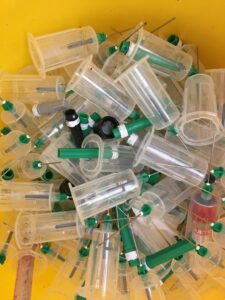Hospital waste crisis in the Philippines. Is there any solution?

Due to the COVID-19 pandemic, hospital waste has increased 2-5 times compared to before the pandemic, increasing the problems of how to dispose of contaminated hospital waste. Recent data from the Department of Environment and Natural Resources show that the Philippines generated more than 19,000 tons of contaminated hospital waste between April to July 2020. In 2020, healthcare facilities in the Philippines produced more than 88,000 metric tons of infectious waste.
In most countries, hospital waste is incinerated but the incineration of any waste is banned in the Philippines and usually ends up in landfills or other undesirable locations including marine environments. Environmentalists warn that infected hospital waste can be a serious problem for human health if not disposed of properly. Landfilling hospital waste does not dispose of hospital waste but it is still increasing.
In most cases, hospital contaminated waste is disinfected in an autoclave. This method does not dispose of the waste, only passes through a certain temperature in the facility to make it non-infectious and then taken to a landfill. It is only a matter of time before existing landfills fill their capacity, as the amount will be too large without any disposal.
In addition to landfills, there is another way to safely dispose of hospital waste using Waste2oil technology, which converts contaminated waste into high-quality oil. This technology is capable of disposing of hospital waste, used face masks, gloves, needles, syringes, and more, and can process up to 18 tons of contaminated hospital waste per day.
Waste2oil technology disposal takes place in a closed cycle, which thermally decomposes the waste materials without producing CO2, which reduces air pollution and its impact on climate change and the environment.
Contaminated waste is poured into the shredder, from where it goes directly to the unit by means of a container, which disposes of it. During this process, the infected waste does not come into contact with the equipment operator. After the recycling process, we get oil, gas, and carbon black. All 3 products can be used to generate electricity.
Laboratory tests of Waste2oil technology in London have shown that the resulting oil has a similar structure to diesel, and can be used as fuel for ships, buses, trucks, and jeepneys or as a fuel for diesel generators to generate electricity. Petrochemical companies, which create new plastics from oil, are also interested in this kind of oil as feedstock.
The Waste2oil unit is used not only for the disposal of hospital waste but also for the disposal of plastics, used tires, sewage sludge, etc. When processing plastic waste, the Waste2oil unit can convert from 1 kg of plastics ~ 1 liter of high-quality oil. From 1 ton of waste, we can produce up to 3 MW of electricity.
The whole technology is placed into 4 containers and can be placed anywhere on a paved level surface. The unit can be powered by gas turbine to produce the electricity needed to run the unit, allowing it to be located in remote area including island. The unit is modular and commissioning takes 2 days only.
Thousands of Filipinos die due to air pollution every year. There are sustainable solutions to the problem, such as the proper implementation of pollution-free technologies that can reduce the amount of infected medical waste instead of putting this hazardous waste into landfills.